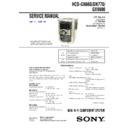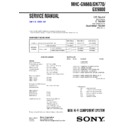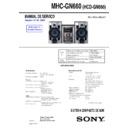Sony HCD-GN660 / HCD-GN770 / HCD-GX9000 / MHC-GN660 / MHC-GN770 / MHC-GX9000 Service Manual ▷ View online
HCD-GN660/GN770/
GX9000
US Model
HCD-GX9000
E Model
HCD-GN660/GN770
Australian Model
HCD-GN770
SERVICE MANUAL
MiNi Hi-Fi COMPONENT SYSTEM
Sony Corporation
Home Audio Division
Published by Sony Techno Create Corporation
Published by Sony Techno Create Corporation
9-877-800-02
2006B02-1
© 2006.02
© 2006.02
SPECIFICATIONS
Ver. 1.1 2006. 02
– Continued on next page –
• HCD-GN660/GN770/GX9000 are the
Amplifier, CD player, tape deck and tuner
section in MHC-GN660/GN770/GX9000.
section in MHC-GN660/GN770/GX9000.
Model Name Using Similar Mechanism
HCD-GX450
CD
CD Mechanism Type
CDM74-F1BD81
Section
Base Unit Name
BU-F1BD81A
Optical Pick-up Name
KSM-215DCP/C2NP
TAPE
Model Name Using Similar Mechanism
NEW
Section
Tape Transport Mechanism Type
CWM43RR35
AUDIO POWER SPECIFICATION
(MHC-GX9000 USA model only)
POWER OUTPUT AND TOTAL HARMONIC
DISTORTION:
(MHC-GX9000 USA model only)
POWER OUTPUT AND TOTAL HARMONIC
DISTORTION:
With 6-ohm loads, both channels driven, from 120 Hz – 10 kHz;
rates 225 watts per channel minimum RMS power, with no more
than 10% total harmonic distortion from 250 miliwatts to rated
output.
rates 225 watts per channel minimum RMS power, with no more
than 10% total harmonic distortion from 250 miliwatts to rated
output.
Amplifier section
MHC-GX9000
Total harmonic distortion
MHC-GX9000
Total harmonic distortion
Less than 0.1%
(6 ohms at 1 kHz, 100 W)
(6 ohms at 1 kHz, 100 W)
MHC-GN770
The following are measured at
Mexican model:
The following are measured at
Mexican model:
AC 127 V, 60 Hz
Other models:
AC 120, 220, 240 V, 50/60 Hz
DIN power output (rated)
170 + 170 watts
(6 ohms at 1 kHz, DIN)
(6 ohms at 1 kHz, DIN)
Continuous RMS power output (reference)
220 + 220 watts
(6 ohms at 1 kHz, 10% THD)
(6 ohms at 1 kHz, 10% THD)
MHC-GN660
The following are measured at
Mexican model:
The following are measured at
Mexican model:
AC 127 V, 60 Hz
Other models:
AC 120, 220, 240 V, 50/60 Hz
Photo : GN770
DIN power output (rated)
150 + 150 watts
(6 ohms at 1 kHz, DIN)
(6 ohms at 1 kHz, DIN)
Continuous RMS power output (reference)
190 + 190 watts
(6 ohms at 1 kHz, 10% THD)
(6 ohms at 1 kHz, 10% THD)
Inputs
VIDEO/MD (AUDIO) IN (phono jacks):
VIDEO/MD (AUDIO) IN (phono jacks):
voltage 250/450 mV, impedance 47
kiloohms
kiloohms
GAME (VIDEO) IN (phono jack):
1 Vp-p, 75 ohms
GAME (AUDIO) IN (phono jack):
voltage 250 mV, impedance 47 kiloohms
MIC (phone jack):
sensitivity 1 mV, impedance 10 kiloohms
Outputs
VIDEO OUT (phono jack):
VIDEO OUT (phono jack):
max. output level
1 Vp-p, unbalanced, Sync negative,
load impedance 75 ohms
1 Vp-p, unbalanced, Sync negative,
load impedance 75 ohms
PHONES (stereo mini jack): accepts headphones of 8 ohms or more
2
HCD-GN660/GN770/GX9000
FRONT SPEAKER:
Use only the supplied speaker
SS-GN880
SS-GN880
SURROUND SPEAKER:
Use only the supplied
(MHC-GN770/ GX9000 only) speaker SS-RS880
Disc player section
System
Compact disc and digital audio system
Laser
Semiconductor laser
(
(
λ
=780 nm)
Emission duration: continuous
Laser Output
Max. 44.6
µ
W*
*This output is the value measured
at a distance of 200 mm from the
objective lens surface on the Optical
Pick-up Block with 7 mm aperture.
at a distance of 200 mm from the
objective lens surface on the Optical
Pick-up Block with 7 mm aperture.
Frequency response
2 Hz – 20 kHz (
±
0.5 dB)
Wave length
780 – 790 nm
Signal-to-noise ratio
More than 90 dB
Dynamic range
More than 90 dB
OPTICAL CD DIGITAL OUT
(MHC-GN770/GN660 only)
(Square optical connector jack, rear panel)
Wave length
(MHC-GN770/GN660 only)
(Square optical connector jack, rear panel)
Wave length
660 nm
Output Level
–18 dBm
Tape deck section
Recording system
4-track 2-channel stereo
Frequency response
50 – 13,000 Hz (
±
3 dB), using Sony
TYPE I tape
Tuner section
FM stereo, FM/AM superheterodyne tuner
FM tuner section
Tuning range
87.5 – 108.0 MHz
Antenna
FM lead antenna
Antenna terminals
75 ohm unbalanced
Intermediate frequency
10.7 MHz
AM tuner section
Tuning range
North and Latin American models:
North and Latin American models:
530 – 1,710 kHz
(with the interval set at 10 kHz)
531 – 1,710 kHz
(with the interval set at 9 kHz)
(with the interval set at 10 kHz)
531 – 1,710 kHz
(with the interval set at 9 kHz)
Middle Eastern models:
531– 1,602 kHz (with the interval set
at 9 kHz)
at 9 kHz)
Other models:
531 – 1,602 kHz (with the interval
set at 9 kHz)
530 – 1,710 kHz (with the interval
set at 10 kHz)
set at 9 kHz)
530 – 1,710 kHz (with the interval
set at 10 kHz)
Antenna
AM loop antenna
Antenna terminals
External antenna terminal
Intermediate frequency
450 kHz
General
Power requirements
North American models:
North American models:
120 V AC, 60 Hz
Australian model:
230 – 240 V AC, 50/60 Hz
Mexican model:
127 V AC, 60 Hz
Argentina models:
220 V AC, 50/60 Hz
Other models:
120 V, 220 V or 230 – 240 V AC, 50/
60 Hz
Adjustable with voltage selector
60 Hz
Adjustable with voltage selector
Power consumption
MHC-GN770
MHC-GN770
215 watts
MHC-GX9000
235 watts
MHC-GN660
175 watts
Dimensions (w/h/d) (Approx.)
HCD-GN770/GX9000/GN660 280 x 360 x 394.5 mm
HCD-GN770/GX9000/GN660 280 x 360 x 394.5 mm
Mass (Approx.)
HCD-GN770
HCD-GN770
12.4 kg
HCD-GX9000
12.0 kg
HCD-GN660
11.5 kg
Supplied accessories:
Remote Commander (1)
Batteries (2)
AM loop antenna (1)
FM lead antenna (1)
Front speaker pads (8)
Surround speaker pads (8)
(MHC-GN770/GX9000 only)
Batteries (2)
AM loop antenna (1)
FM lead antenna (1)
Front speaker pads (8)
Surround speaker pads (8)
(MHC-GN770/GX9000 only)
Design and specifications are subject to change without notice.
After correcting the original service problem, perform the following
safety checks before releasing the set to the customer:
Check the antenna terminals, metal trim, “metallized” knobs, screws,
and all other exposed metal parts for AC leakage. Check leakage as
described below.
safety checks before releasing the set to the customer:
Check the antenna terminals, metal trim, “metallized” knobs, screws,
and all other exposed metal parts for AC leakage. Check leakage as
described below.
LEAKAGE
The AC leakage from any exposed metal part to earth ground and
from all exposed metal parts to any exposed metal part having a
return to chassis, must not exceed 0.5 mA (500 microamperes).
Leakage current can be measured by any one of three methods.
from all exposed metal parts to any exposed metal part having a
return to chassis, must not exceed 0.5 mA (500 microamperes).
Leakage current can be measured by any one of three methods.
1. A commercial leakage tester, such as the Simpson 229 or RCA
WT-540A. Follow the manufacturers’ instructions to use these
instruments.
instruments.
2. A battery-operated AC milliammeter. The Data Precision 245
digital multimeter is suitable for this job.
3. Measuring the voltage drop across a resistor by means of a
VOM or battery-operated AC voltmeter. The “limit” indication
is 0.75 V, so analog meters must have an accurate low-voltage
scale. The Simpson 250 and Sanwa SH-63Trd are examples
of a passive VOM that is suitable. Nearly all battery operated
digital multimeters that have a 2V AC range are suitable. (See
Fig. A)
is 0.75 V, so analog meters must have an accurate low-voltage
scale. The Simpson 250 and Sanwa SH-63Trd are examples
of a passive VOM that is suitable. Nearly all battery operated
digital multimeters that have a 2V AC range are suitable. (See
Fig. A)
SAFETY CHECK-OUT
To Exposed Metal
Parts on Set
0.15
µ
F
1.5 k
Ω
AC
Voltmeter
(0.75 V)
Voltmeter
(0.75 V)
Earth Ground
Fig. A. Using an AC voltmeter to check AC leakage.
3
HCD-GN660/GN770/GX9000
TABLE OF CONTENTS
1.
SERVICING NOTES
................................................
4
2.
GENERAL
Location of Controls ........................................................
5
3.
DISASSEMBLY
3-1.
Disassembly Flow ...........................................................
7
3-2.
Case .................................................................................
8
3-3.
Loading Panel Assy .........................................................
8
3-4.
Front Panel Assy ..............................................................
9
3-5.
CD Mechanism Deck (CDM74-F1BD81) ......................
9
3-6.
Tape Mechanism Deck, Game Board .............................. 10
3-7.
CD Switch Board, Panel Board ....................................... 10
3-8.
Switch Board ................................................................... 11
3-9.
Tuner Pack ....................................................................... 11
3-10. Primary Board ................................................................. 12
3-11. Rear Panel ........................................................................ 12
3-12. Main Board ...................................................................... 13
3-13. Surround Board, PA Board .............................................. 13
3-14. Power Transformer .......................................................... 14
3-15. Driver Board, SW Board ................................................. 14
3-16. BD Board, Optical Pick-Up (KSM-215DCP/C2NP) ...... 15
3-17. Sensor Board ................................................................... 15
3-18. Motor (TB) Board ........................................................... 16
3-19. Motor (LD) Board ........................................................... 16
3-11. Rear Panel ........................................................................ 12
3-12. Main Board ...................................................................... 13
3-13. Surround Board, PA Board .............................................. 13
3-14. Power Transformer .......................................................... 14
3-15. Driver Board, SW Board ................................................. 14
3-16. BD Board, Optical Pick-Up (KSM-215DCP/C2NP) ...... 15
3-17. Sensor Board ................................................................... 15
3-18. Motor (TB) Board ........................................................... 16
3-19. Motor (LD) Board ........................................................... 16
4.
TEST MODE
.............................................................. 17
5.
MECHANICAL ADJUSTMENTS
....................... 21
6.
ELECTRICAL ADJUSTMENTS
Deck section .................................................................... 21
CD Section ...................................................................... 22
CD Section ...................................................................... 22
Notes on chip component replacement
• Never reuse a disconnected chip component.
• Notice that the minus side of a tantalum capacitor may be
• Notice that the minus side of a tantalum capacitor may be
damaged by heat.
Flexible Circuit Board Repairing
• Keep the temperature of soldering iron around 270˚C
during repairing.
• Do not touch the soldering iron on the same conductor of the
circuit board (within 3 times).
• Be careful not to apply force on the conductor when soldering
or unsoldering.
CAUTION
Use of controls or adjustments or performance of procedures
other than those specified herein may result in hazardous
radiation exposure.
other than those specified herein may result in hazardous
radiation exposure.
This appliance is classified as
a CLASS 1 LASER product.
This label is located on the rear
exterior.
a CLASS 1 LASER product.
This label is located on the rear
exterior.
SAFETY-RELATED COMPONENT WARNING!!
COMPONENTS IDENTIFIED BY MARK
0
OR DOTTED LINE WITH
MARK
0
ON THE SCHEMATIC DIAGRAMS AND IN THE PARTS
LIST ARE CRITICAL TO SAFE OPERATION. REPLACE THESE
COMPONENTS WITH SONY PARTS WHOSE PART NUMBERS
APPEAR AS SHOWN IN THIS MANUAL OR IN SUPPLEMENTS
PUBLISHED BY SONY.
COMPONENTS WITH SONY PARTS WHOSE PART NUMBERS
APPEAR AS SHOWN IN THIS MANUAL OR IN SUPPLEMENTS
PUBLISHED BY SONY.
7.
DIAGRAMS
7-1.
Circuit Board Location .................................................... 26
7-2.
Block Diagram – CD Section – ...................................... 28
7-3.
Block Diagram – Tuner/Tape Deck Section – ................ 29
7-4.
Block Diagram – Main Section – ................................... 30
7-5.
Block Diagram – Display/Power Section – .................... 31
7-6.
Printed Wiring Board – BD Board – .............................. 32
7-7.
Schematic Diagram – BD Board – ................................. 33
7-8.
Printed Wiring Board – CD Mechanism Board – ........... 34
7-9.
Schematic Diagram – CD Mechanism Board – ............. 35
7-10. Printed Wiring Boards – Main Board – .......................... 36
7-11. Schematic Diagram – Main Board (1/3) – ..................... 37
7-12. Schematic Diagram – Main Board (2/3) – ..................... 38
7-13. Schematic Diagram – Main Board (3/3) – ..................... 39
7-14. Printed Wiring Boards
7-11. Schematic Diagram – Main Board (1/3) – ..................... 37
7-12. Schematic Diagram – Main Board (2/3) – ..................... 38
7-13. Schematic Diagram – Main Board (3/3) – ..................... 39
7-14. Printed Wiring Boards
– Game, CD Switch Board – ........................................... 40
7-15. Schematic Diagram
– Game, CD Switch Board – ........................................... 41
7-16. Printed Wiring Board – PA Board – ............................... 42
7-17. Schematic Diagram – PA Board – .................................. 43
7-18. Schematic Diagram –Panel Board (1/2) – ...................... 44
7-19. Schematic Diagram –Panel Board (2/2) – ...................... 45
7-20. Printed Wiring Board – Panel Board – ........................... 46
7-21. Printed Wiring Boards – Primary Board – ..................... 47
7-22. Schematic Diagram – Primary Board – .......................... 48
7-23. Schematic Diagram – Surround Board – ........................ 48
7-24. Printed Wiring Board – Surround Board – ..................... 49
7-25. IC Block Diagram ........................................................... 50
7-26. IC Pin Function Description ............................................ 51
7-17. Schematic Diagram – PA Board – .................................. 43
7-18. Schematic Diagram –Panel Board (1/2) – ...................... 44
7-19. Schematic Diagram –Panel Board (2/2) – ...................... 45
7-20. Printed Wiring Board – Panel Board – ........................... 46
7-21. Printed Wiring Boards – Primary Board – ..................... 47
7-22. Schematic Diagram – Primary Board – .......................... 48
7-23. Schematic Diagram – Surround Board – ........................ 48
7-24. Printed Wiring Board – Surround Board – ..................... 49
7-25. IC Block Diagram ........................................................... 50
7-26. IC Pin Function Description ............................................ 51
8.
EXPLODED VIEWS
8-1.
Case, Rear Panel Section ................................................. 57
8-2.
Front Panel Section ......................................................... 58
8-3.
Chassis Section ................................................................ 59
8-4.
CD Mechanism Deck Section-1
(CDM74-F1BD81) .......................................................... 60
8-5. CD Mechanism Deck Section-2
(CDM74-F1BD81) .......................................................... 61
9.
ELECTRICAL PARTS LIST
................................ 62
4
HCD-GN660/GN770/GX9000
SECTION 1
SERVICING NOTES
NOTES ON HANDLING THE OPTICAL PICK-UP BLOCK
OR BASE UNIT
OR BASE UNIT
The laser diode in the optical pick-up block may suffer electrostatic
break-down because of the potential difference generated by the
charged electrostatic load, etc. on clothing and the human body.
During repair, pay attention to electrostatic break-down and also
use the procedure in the printed matter which is included in the
repair parts.
The flexible board is easily damaged and should be handled with
care.
break-down because of the potential difference generated by the
charged electrostatic load, etc. on clothing and the human body.
During repair, pay attention to electrostatic break-down and also
use the procedure in the printed matter which is included in the
repair parts.
The flexible board is easily damaged and should be handled with
care.
NOTES ON LASER DIODE EMISSION CHECK
The laser beam on this model is concentrated so as to be focused on
the disc reflective surface by the objective lens in the optical pick-
up block. Therefore, when checking the laser diode emission, observe
from more than 30 cm away from the objective lens.
the disc reflective surface by the objective lens in the optical pick-
up block. Therefore, when checking the laser diode emission, observe
from more than 30 cm away from the objective lens.
LASER DIODE AND FOCUS SEARCH OPERATION CHECK
Carry out the “S curve check” in “CD section adjustment” and check
that the S curve waveform is output several times.
that the S curve waveform is output several times.
• MODEL IDENTIFICATION
– Back Panel –
– Back Panel –
MODEL
PART No.
GN770: E2, E3models
4-252-722-0[]
GX9000
4-252-722-1[]
GN770: AUS model
4-252-722-2[]
GN770: E51 model
4-252-722-3[]
GN770: Mexican model
4-252-722-4[]
GN660: E2, E3models
4-252-555-0[]
GN770: E51 model
4-252-555-1[]
GN770: Mexican model
4-252-555-2[]
GN660: AR model
4-252-555-3[]
• Abbreviation
E2
: 120 V AC Area in E model
E3
: 240 V AC Area in E model
E51 : Chilean and Peruvian model
AUS : Australian model
AR
AUS : Australian model
AR
: Argentine model
PART No.



